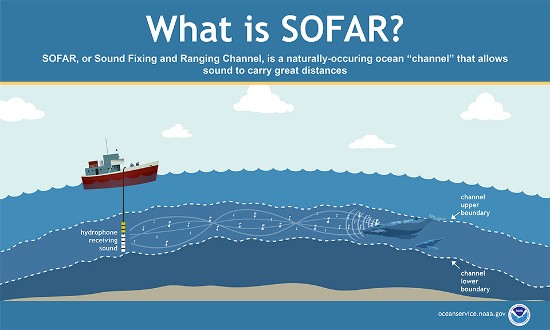Woods Hole Oceanographic Institute (WHOI) in Massachusetts is deploying a marine equivalent to GPS using an ocean full of sonic beacons that can triangulate the position of every tagged fish, whale, or anything else that requires tracking.
GPS doesn’t work when trying to locate anything under the ocean surface because radio signals cannot penetrate seawater. So today, when research scientists want to track a whale, a Great White Shark, or other wildlife, they tag it. When the tagged creature surfaces or is caught the location is then transmitted to a satellite. Fishers that come across tagged wildlife are compensated when they return the tags to the researchers who created them.
WHOI has been working on sonic communication systems since World War Two, originally to find enemy submarines and the locations of mines, while helping to hide American marine assets. Emulating how whales communicate, scientists discovered a water layer between approximately 600 and 1,200 metres (2,000 and 4,000 feet) that could channel low-frequency sounds and transmit them over long distances. They dubbed this layer SOFAR, an acronym for what is now known as the Sound Fixing and Ranging channel.
How does the SOFAR channel work? The ocean is multilayered determined by water temperatures, salinity and pressure. Sound reacts differently in its different layers, speeding up in warmer water and slowing down in colder dense water. But in between the warm and the cold layers lies SOFAR bounded by what essentially is a ceiling and floor. Sounds within the SOFAR channel bounce back on forth between the warm water ceiling and cold dense floor and can be channelled horizontally allowing for sonic communication over hundreds of kilometres before becoming attenuated.
WHOI is deploying buoys throughout the ocean that transmit a 32-second location signal twice a day. They call these signals “pongs” as opposed to “pings” which are used by naval sonar. Pongs transmit at a low frequency of 300 Hertz, as opposed to pings at 18 Kilohertz.
With pongs being transmitted from multiple locations, it becomes possible to triangulate the location of any device with an onboard receiver.
The ocean is full of listening and sampling devices. The ARGO Program alone represents a constellation of thousands of instrumentation packages drifting with the currents and moving up and down through various water layers while gathering enormous amounts of data on temperature, salinity, and composition.
Although SOFAR was originally a classified naval secret, in the 1990s it was made accessible for scientific research. And now it is being used by universities and companies to deploy increasingly smaller submersibles, and tags that can be applied to a range of marine wildlife and more.
Researchers are tagging swordfish and have revealed previously unknown behaviours. For example, this species spends much of its day in water 800 metres (2,650 feet) deep, but at night it rises near the surface. An ecologist at WHOI believes the behaviour conforms with warm water eddies where the species’ food can be found.
In another application, SOFAR is being used to track carbon in the ocean. A University of Rhode Island researcher has developed Minions, tiny underwater floats designed to monitor marine organic matter as it drifts down from the surface to the depths. Understanding the mechanism could become a guide for projects seeking to permanently sequester carbon in the ocean’s deepest parts.
As more buoys and devices are deployed, the world’s oceans will become as wired as the surface of our planet is today, but this time instead of satellite-based GPS, it will be a sonic network.
















